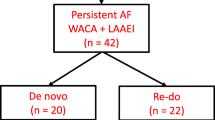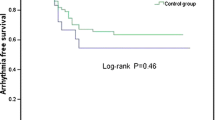Abstract
Background
The left atrial appendage (LAA) can be a source of atrial fibrillation (AF) triggering or a part of reentry. We sought to determine the characteristics and clinical outcomes of patients with LAA potential delay including electrical isolation (LAAEI) following LA anterior wall (LAAW) ablation for AF.
Methods
LAAW ablation cases were collected from among 846 patients who underwent catheter ablation (CA). A total of 89 patients were enrolled; they were divided into three groups according to the extent of LAA potential injury. The ejection fractions (EFs) of the LAA and LA were measured by means of LA angiograms.
Results
The mean age of all patients was 56.2 ± 10.7 years (74 males, 83 %). In 47 of the 89 patients, an LAA potential delay was identified after LAAW ablation (group 2). LAAEI was seen in 18 patients (group 3). In the remaining 24 patients, there was no LAA potential delay or LAAEI (group 1). The mean EF decreased significantly after CA in group 3 (P < 0.001). At 21-month follow-up, three patients (17 %) in group 3 had recurrence compared with 11 (42 %) in group 2 and 12 (46 %) in group 3 (P = 0.028). In multivariate analysis, diabetes mellitus and LAA potential delay were independent predictors of AF recurrence (P = 0.021, P = 0.008, respectively).
Conclusion
Ablation of the LA anterior wall near the insertion of Bachmann’s bundle and the neck of the LAA resulting in LAA potential delay or electrical isolation is effective in preventing recurrence of atrial fibrillation.




Similar content being viewed by others
References
Verma, A., Kilicaslan, F., Pisano, E., Marrouche, N. F., Fanelli, R., Brachmann, J., et al. (2005). Response of atrial fibrillation to pulmonary vein antrum isolation is directly related to resumption and delay of pulmonary vein conduction. Circulation, 112(5), 627–635.
Ouyang, F., Antz, M., Ernst, S., Hachiya, H., Mavrakis, H., Deger, F. T., et al. (2005). Recovered pulmonary vein conduction as a dominant factor for recurrent atrial tachyarrhythmias after complete circular isolation of the pulmonary veins: lessons from double Lasso technique. Circulation, 111(2), 127–135.
Nademanee, K., McKenzie, J., Kosar, E., Schwab, M., Sunsaneewitayakul, B., Vasavakul, T., et al. (2004). A new approach for catheter ablation of atrial fibrillation: mapping of the electrophysiologic substrate. Journal of the American College of Cardiology, 43(11), 2044–2053.
Takahashi, Y., Sanders, P., Rotter, M., & Haissaguerre, M. (2005). Disconnection of the left atrial appendage for elimination of foci maintaining atrial fibrillation. Journal of Cardiovascular Electrophysiology, 16(8), 917–919.
Di Biase, L., Burkhardt, J. D., Mohanty, P., Sanchez, J., Mohanty, S., Horton, R., et al. (2010). Left atrial appendage: an underrecognized trigger site of atrial fibrillation. Circulation, 122(2), 109–118.
Di Biase, L., Santangeli, P., & Natale, A. (2013). How to ablate long-standing persistent atrial fibrillation? Current Opinion in Cardiology, 28(1), 26–35.
Chan, C. P., Wong, W. S., Pumprueg, S., Veerareddy, S., Billakanty, S., Ellis, C., et al. (2010). Inadvertent electrical isolation of the left atrial appendage during catheter ablation of persistent atrial fibrillation. Heart Rhythm, 7(2), 173–180.
Calkins, H., Brugada, J., Packer, D. L., Cappato, R., Chen, S. A., Crijns, H. J., et al. (2007). HRS/EHRA/ECAS expert Consensus Statement on catheter and surgical ablation of atrial fibrillation: recommendations for personnel, policy, procedures and follow-up. A report of the Heart Rhythm Society (HRS) Task Force on catheter and surgical ablation of atrial fibrillation. Heart Rhythm, 4(6), 816–861.
Natale, A., Raviele, A., Arentz, T., Calkins, H., Chen, S. A., Haissaguerre, M., et al. (2007). Venice Chart international consensus document on atrial fibrillation ablation. Journal of Cardiovascular Electrophysiology, 18(5), 560–580.
Park, H. C., Shin, J., Ban, J. E., Choi, J. I., Park, S. W., & Kim, Y. H. (2012). Left atrial appendage: morphology and function in patients with paroxysmal and persistent atrial fibrillation. The International Journal of Cardiovascular Imaging.
Pollak, A., & Falk, R. H. (1995). Aggravation of postcardioversion atrial dysfunction by sotalol. Journal of the American College of Cardiology, 25(3), 665–671.
Nagueh, S. F., Appleton, C. P., Gillebert, T. C., Marino, P. N., Oh, J. K., Smiseth, O. A., et al. (2009). Recommendations for the evaluation of left ventricular diastolic function by echocardiography. European Journal of Echocardiography, 10(2), 165–193.
Lang, R. M., Bierig, M., Devereux, R. B., Flachskampf, F. A., Foster, E., Pellikka, P. A., et al. (2005). Recommendations for chamber quantification: a report from the American Society of Echocardiography’s Guidelines and Standards Committee and the Chamber Quantification Writing Group, developed in conjunction with the European Association of Echocardiography, a branch of the European Society of Cardiology. Journal of the American Society of Echocardiography, 18(12), 1440–1463.
Leftheriotis, D., Yoshiga, Y., Kuck, K. H., & Ouyang, F. (2011). Masked left atrial appendage isolation during ablation of persistent atrial fibrillation. Heart Rhythm, 8(1), 137–141.
Tilz, R. R., Chun, K. R., Schmidt, B., Fuernkranz, A., Wissner, E., Koester, I., et al. (2010). Catheter ablation of long-standing persistent atrial fibrillation: a lesson from circumferential pulmonary vein isolation. Journal of Cardiovascular Electrophysiology, 21(10), 1085–1093.
Sanders, P., Jais, P., Hocini, M., Hsu, L. F., Scavee, C., Sacher, F., et al. (2004). Electrophysiologic and clinical consequences of linear catheter ablation to transect the anterior left atrium in patients with atrial fibrillation. Heart Rhythm, 1(2), 176–184.
Ho, S. Y., Sanchez-Quintana, D., Cabrera, J. A., & Anderson, R. H. (1999). Anatomy of the left atrium: implications for radiofrequency ablation of atrial fibrillation. Journal of Cardiovascular Electrophysiology, 10(11), 1525–1533.
Ho, S. Y., Anderson, R. H., & Sanchez-Quintana, D. (2002). Atrial structure and fibres: morphologic bases of atrial conduction. Cardiovascular Research, 54(2), 325–336.
Kumagai, K., Uno, K., Khrestian, C., & Waldo, A. L. (2000). Single site radiofrequency catheter ablation of atrial fibrillation: studies guided by simultaneous multisite mapping in the canine sterile pericarditis model. Journal of the American College of Cardiology, 36(3), 917–923.
Al-Saady, N. M., Obel, O. A., & Camm, A. J. (1999). Left atrial appendage: structure, function, and role in thromboembolism. Heart, 82(5), 547–554.
Author information
Authors and Affiliations
Corresponding author
Rights and permissions
About this article
Cite this article
Park, HC., Lee, D., Shim, J. et al. The clinical efficacy of left atrial appendage isolation caused by extensive left atrial anterior wall ablation in patients with atrial fibrillation. J Interv Card Electrophysiol 46, 287–297 (2016). https://doi.org/10.1007/s10840-016-0116-7
Received:
Accepted:
Published:
Issue Date:
DOI: https://doi.org/10.1007/s10840-016-0116-7




